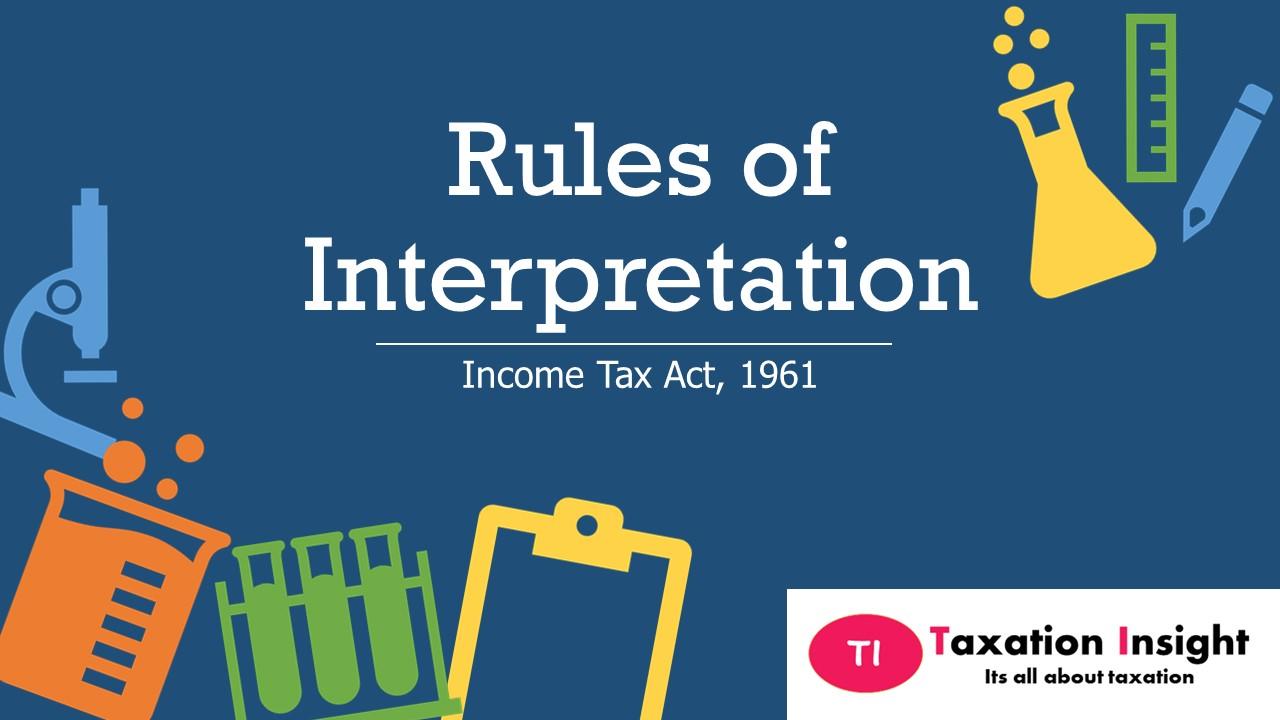
Rules of Interpretation of Income Tax Act, 1961
The Provisions of Income Tax Act, 1961 should be followed by every taxpayer, however, there is a certain situation where provisions are not very clear and sometimes don’t cover such situations as Lawmakers are not always very efficient to cover all the situations and cases.
In such a case, rules of interpretation come into the picture. These rules are the principles that help in the interpretation of the law. The basic objective behind these rules is to ascertain the intention of the lawmakers. These rules are not static and they keep on evolving.
Sometimes, there may be a situation, where two or more rules of interpretation are applicable. In such a case, the court will decide the most appropriate rule of interpretation considering the facts of the case.
Significant rules of Interpretations used by Courts
- Rule of Literal interpretation:- There is a famous doctrine that says “Judges do not legislate, they only interpret law“. This rule stipulates that the intention of the legislation must be found in the words used by the legislation itself. Attention must be given to what is said in law and what is not said and this rule is applicable where the provision of the legislative intent is unambiguous. Nothing should be added or subtracted.
Every statute has to be interpreted by the judges the way it is meant to be understood. The literal rule is the first rule applied by the judges. The literal rule means that a judge has to consider what the statute says ‘literally’, i.e its simple plain meaning without any ambiguity.
- Mischief rule:– This rule is also commonly known as “Heydon’s Rule or Purposive construction“. This rule originated in the 16th century in Heydon’s case. In this rule, the law position is examined before the amendment or enactment of the Act, and the mischief rule sought to find out the remedies. The following aspects are looked at-
– What was the law before the provision was introduced or amended?
– What was the mischief or the defect for which earlier provision of law did not provide a remedy?
– What remedy has the Parliament effected in the provisions of law to cure the mischief or defect?
– What is the intended effect of such a remedy?
The court then has to make a construction that suppresses the mischief and advances the remedy.
- The Golden rule:– In this rule of interpretation, the normal meaning of the words of a provision is overlooked to avoid an absurd result. This rule is a compromise between the literal rule and the mischief rule. Unlike in literal interpretation, the words of the statute give plain and ordinary meaning, however, if this leads to an irrational result and the legislative intention is not in line, the court can depart from such meaning.
In such a case, the court would also look at the context in which a provision appears. The same words may mean one thing in one context and another in a different context. While ascertaining the true intention of the legislature, the court must not only look at the words used by the legislature but also have regard to the context and the setting in which they occur. The meaning of words in an enactment is not to be ascertained by reading them in isolation.
- Rule of Harmonious construction:- In this rule, the entire statute must be read as a whole. Further, all the parts of a section should be read harmoniously. Construction should be such that it provides meaning to all the parts of the statute. Any construction of provision which creates inconsistency between different sections or parts of the statute, then such construction should be avoided.
Harmonious construction is a principle of statutory interpretation used in the Indian legal system. It holds that when two provisions of a legal text seem to conflict, they should be interpreted so that each has a separate effect and neither is redundant or nullified
- Principle of Beneficial Construction:- This interpretation is more relevant where two views are possible and the construction which gives most beneficial to the taxpayers, such construction should be adopted. This principle is also widely used in the case of interpretation of fiscal laws. This construction involves giving the widest meaning possible to the statutes.
- Rule of ejusdem generis:– This rule is used when particular words about a class or category are followed by general words. In that case, general words are construed as limited to things of the same kind. Ejusdem Generis means “of the same kind and nature”. When a list of two or more specific descriptors is followed by more general descriptors, the otherwise wide meaning of the general descriptors must be restricted to the same class, if any, of the specific words that precede them
- Principle of nocitur a sociius: This rule implies that the meaning of a word may be ascertained by reference to words associated with it. Words derive color from the surrounding words. The principle of Noscitur a Sociis is a rule of construction. It is one of the rules of the language used by the courts to interpret legislation. This means that the meaning of an unclear word or phrase should be determined by the words immediately surrounding it.
- Principle of stare decisis: This rule stipulates that a view that is operating for a long and is accepted and acted upon should not be easily departed from. The doctrine of stare decisis refers to the rule in which the court would follow previous judicial decisions in future instances. As a result, when the same questions or arguments are addressed in later instances, the court will follow the findings of previous cases.
We hope you like reading our above article and that you might have gained some insight into the rules of interpretation. In case you have any doubts or any clarification is required, then please feel free to write us at [email protected]
Taxation Insight
